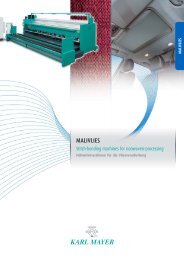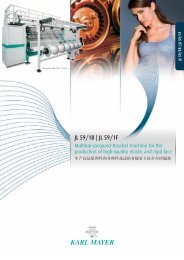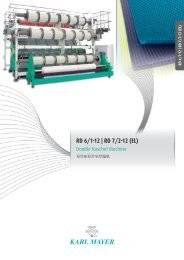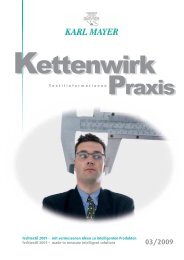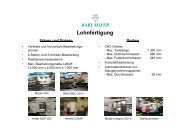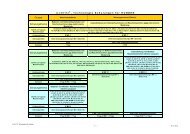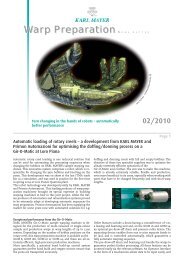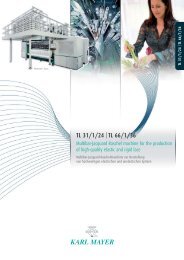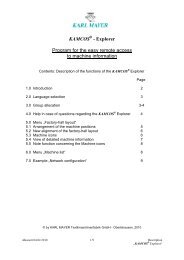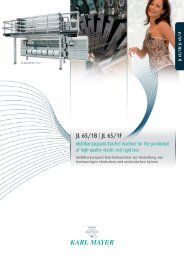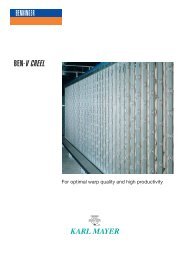Praxis Praxis - KARL MAYER Textilmaschinenfabrik GmbH
Praxis Praxis - KARL MAYER Textilmaschinenfabrik GmbH
Praxis Praxis - KARL MAYER Textilmaschinenfabrik GmbH
You also want an ePaper? Increase the reach of your titles
YUMPU automatically turns print PDFs into web optimized ePapers that Google loves.
Kettenwirk<br />
T e x t i l i n f o r m a t i o n e n<br />
<strong>Praxis</strong><br />
Erfolge ernten mit dem richtigen Netz<br />
Catching success with the right net<br />
02/2006
CONTENTS<br />
TEXTILE INFORMATION<br />
FROM KETTENWIRK-PRAXIS<br />
2 FASHION<br />
HOLDING ALL THE TRUMP CARDS – IN THE SHAPE OF THE NEW ML 35 C<br />
ELASTIC GMBH IS ON THE UP AND UP, WITH A NEW STRATEGY AND NEW MACHINES PAGE 4<br />
DEFYING GRAVITY – WITH THE ML 35 C<br />
TWO NEW BRA FABRICS PRODUCED ON THE ML 35 C PAGE 4<br />
HOSIERY WITH HANDS AND FEET<br />
LEGWEAR PRODUCED ON THE RDPJ 6/2 GIVES THE TOES FREEDOM TO MOVE PAGE 5<br />
SPACER FABRICS IN CLOTHING<br />
OUTDOOR JACKETS MADE FROM SPACER FABRICS, FROM PRADA PAGE 7<br />
WARP-KNITTED SPACER FABRICS – THE BEST WAY OF CATCHING A FAIRYTALE PRINCE<br />
SPACER TEXTILES PRODUCED ON THE RD 4 FOR WEARING NEXT TO THE SKIN PAGE 8<br />
CREATING SPECIAL EFFECTS WITH MOULINAGE DU PLOUY<br />
FANCY YARNS PRODUCED BY MOULINAGE DU PLOUY FOR WARP-KNITTED LACE PAGE 9<br />
LACE: THE CROWNING GLORY IN THE PALACE OF TIANHAI LACE<br />
GUANGZHOU TIANHAI LACE CO. LTD USES THE NEW TEXTRONIC ® AND JACQUARDTRONIC ®<br />
LACE MACHINES TO PLACE THE CROWN FIRMLY ON THE HEAD WARP-KNITTED LACE PAGE 10<br />
THE OUTFIT TO BRING OUT THE “LARA CROFT” IN A WOMAN<br />
GAINING GROUND WITH THE LACE PRODUCED ON THE JL 36/1-F PAGE 11<br />
12 HOME TEXTILES<br />
CARB-O-NARA - THE TRENDSETTER LAMP FOR SELF-DEVELOPMENT<br />
WITH RADIUS-DESIGN LAMPS TEXTILE SPACER SHINES IN A NEW LIGHT PAGE 12<br />
3D WARP-KNITTED FABRICS – THE MATERIAL FOR EVERY FORM OF SEATING<br />
FUNCTIONAL HOME FASHION MADE BY BONTEMPI FROM SPACER WARP-KNITTED FABRICS PAGE 13<br />
FLAME-RETARDANT SPACER TEXTILES<br />
ASTRA UPHOLSTERY FABRIC FROM CRÉATION BAUMANN WINS AN AWARD PAGE 14<br />
15 TECHNICAL TEXTILES<br />
STITCH-BONDED FABRICS FEATURING A DENSITY GRADIENT – FROM<br />
A “HANDICRAFT” TO INDUSTRIAL PRODUCTION PAGE 15<br />
THICK, MULTIAXIAL FABRICS – A SIMPLE TEST METHOD PAVES THE WAY FOR<br />
THEIR USE IN PRACTICE<br />
STUDY ON EVALUATING VERY THICK, MULTILAYER, MULTIAXIAL,<br />
SEMI-FINISHED PRODUCTS MADE FROM HIGH-PERFORMANCE YARNS PAGE 17<br />
MANIPULATING THE STRUCTURE OF MALIVLIES WEBS<br />
RESULTS OF RESEARCH CARRIED OUT AT THE SAXONY TEXTILE RESEARCH INSTITUTE<br />
(SÄCHSISCHES TEXTILFORSCHUNGSINSTITUT E. V.) INTO THE STRUCTURING/PATTERNING<br />
OF MALIVLIES TEXTILES PAGE 19<br />
SPACER TEXTILES IN A RESIN COAT – A TEXTILE TIT-BIT FOR SPECIALISTS IN FRC<br />
INNOVATIVE SPACER TEXTILE CREATES A NEW FIBRE-REINFORCED COMPOSITE PAGE 21<br />
TESTING OF 3D, WARP-KNITTED, SHORT-STRETCH BANDAGES ON THE “SKIN TESTER”<br />
PHYSIOLOGICAL TESTS AND PRACTICAL TRIALS PAGE 22<br />
THE PERFECT MATERIAL FOR TACKLING COMFORT PROBLEMS<br />
JACQUARD-PATTERNED SPACER TEXTILES IN NIKE SHOX 2:40 RUNNING SHOES PAGE 25<br />
FOOTBALL IN THE DRIVING SEAT<br />
WARP-KNITTED FABRICS IN TOTAL CONTROL AT THE 2006 WORLD CUP PAGE 26<br />
OPTIMISATION OF EYE IMPLANTS<br />
CORNEAL PROSTHESIS BASED ON TEXTILES PAGE 27<br />
“ROLL BACK MALARIA” WITH WARP-KNITTED MOSQUITO NETS<br />
MOSQUITO NETS – ONE OF THE MOST EFFECTIVE PREVENTIVE MEASURES<br />
IN THE FIGHT AGAINST MALARIA PAGE 29<br />
As to the figures:<br />
Hosiery produced on the RDPJ 6/2 gives the toes more freedom to move<br />
The “Tweed” collection from Bontempi turns conventional chair design on end<br />
Multiaxial fabric – a material for almost every occasion<br />
The Nike Shox 2:40 running shoe – makes running pure pleasure<br />
Live comfortably with ADO – produced efficiently with <strong>KARL</strong> <strong>MAYER</strong><br />
Ultrasonic welding – the perfect solution for cutting warp-knitted spacer textiles<br />
“Sleeping comfortably with warp-knitted spacer textiles” – a training course organised by <strong>KARL</strong> <strong>MAYER</strong> and Phi-ton for the “newly awakened”<br />
<strong>KARL</strong> <strong>MAYER</strong> at CITME 2006 – other countries, other markets - and trade fairs with quite specific exhibits<br />
Kettenwirk-<strong>Praxis</strong> 2/2006
TEXTILE INFORMATION<br />
FROM KETTENWIRK-PRAXIS<br />
CONTENTS<br />
31 WARP PREPARATION<br />
FIRST-CLASS TECHNOLOGY FOR MAXIMUM COMFORT IN THE HOME<br />
ADO EXTENDS ITS VERTICALLY INTEGRATED PRODUCTION STRATEGY WITH<br />
THE NEW OPT-O-MATIC FROM <strong>KARL</strong> <strong>MAYER</strong> PAGE 31<br />
33 SPOTLIGHTS<br />
ATTRACTIVE SEALING TECHNIQUE FOR PROCESSING FABRIC EDGES<br />
INVESTIGATIONS INTO CUTTING TEXTILE SUBSTRATES, PARTICULARLY SPACER TEXTILES,<br />
USING ULTRASOUND PAGE 33<br />
PRECISION HEAT-SETTING – AT THE PUSH OF A BUTTON<br />
THE MONTEX 6500 CONVEYOR-BELT STENTER FROM MONFORTS FOR FINISHING<br />
HIGHDISTANCE ® MATERIALS PAGE 34<br />
THE SU DRIVE - MACHINE COMMANDER (RETIRED)<br />
THE LAST SU DRIVE HAS BEEN DELIVERED – HOMAGE TO<br />
A TRIED-AND-TESTED TECHNOLOGY PAGE 35<br />
24 NEEDLES CLOSER TO CUSTOMER REQUIREMENTS<br />
<strong>KARL</strong> <strong>MAYER</strong>’S JANUARY RELEASE: THE NEW PATTERNING POSSIBILITIES OFFERED<br />
BY THE TL 66/1/36 PAGE 36<br />
GAINING TIME USING A QUESTION AND ANSWER GAME WHEN ORDERING SPARE PARTS<br />
ORDER FORM FOR PATTERN WHEELS AND PATTERN CHAINS FROM <strong>KARL</strong> <strong>MAYER</strong><br />
AS OF APRIL 2006 PAGE 37<br />
RECORD-BREAKING MARKET AND TRADE FAIR <strong>KARL</strong> <strong>MAYER</strong> AT THE 4 TH<br />
NORTH AMERICA EXHIBITION, 28 TO 30 MARCH 2006 PAGE 38<br />
TECHTEXTIL<br />
ANNUAL MEETING FOR THE KNITTING SECTOR<br />
MEETING OF THE GERMAN SECTION OF THE IFWS, 22-23 MAY 2006 PAGE 38<br />
COME, SEE AND UNDERSTAND - WELCOME TO <strong>KARL</strong> <strong>MAYER</strong><br />
TRAINING ON THE THEME: COMFORT FOR THE SLEEPER WITH WARP-KNITTED 3D FABRICS PAGE 39<br />
“CROSSING THE BORDER” – WITH SPACER TEXTILES<br />
SERIES OF LECTURES HELD IN ASIA BY <strong>KARL</strong> <strong>MAYER</strong> IN APRIL 2006 PAGE 40<br />
41 TIMER<br />
OPERATING SUCCESSFULLY ALL OVER THE WORLD – WITH THE RIGHT MACHINES<br />
<strong>KARL</strong> <strong>MAYER</strong> AT CITME, 17 TO 21 OCTOBER IN PEKING PAGE 41<br />
42 PATENT<br />
PATENTS – PUBLICATIONS AND SPECIFICATIONS PAGE 42<br />
45 PATTERNS<br />
Kettenwirk<br />
T e x t i l i n f o r m a t i o n e n<br />
Erfolge ernten mit dem richtigen Netz<br />
Catching success with the right net<br />
<strong>Praxis</strong><br />
02/2006<br />
IMPRESSUM<br />
Herausgeber, Verlag, Vertrieb:<br />
<strong>KARL</strong> <strong>MAYER</strong> <strong>Textilmaschinenfabrik</strong> <strong>GmbH</strong>, Postfach 1120,<br />
D-63166 Obertshausen, Tel.: 06104/402-0, www.karlmayer.de<br />
Redaktion:<br />
Dipl.-Ing. Ulrike Schlenker, Verlagsanschrift, Tel.: 06104/402-274,<br />
Fax: 06104/44574, e-mail: uschlenker@karlmayer.de<br />
Design und Konzeption:<br />
LAHREMEDIA <strong>GmbH</strong>, Legesweg 4, D-63762 Großostheim 2<br />
Druck:<br />
Max Dorn Presse, D-63179 Obertshausen<br />
Fotos:<br />
Jean-Luc Valentin<br />
Bezugspreis/Cost of subscription:<br />
Jahresabbonnement (4 Hefte): 36,- EUR (inkl. 7 % MwSt.) +<br />
Versandspesen, Bestellungen direkt beim Verlag, beim<br />
Buchhandel oder bei den Vertretungen.<br />
Abbestellungen bis 8 Wochen vor Jahresende.<br />
Annually (4 editions): 36,- EUR (incl. VAT) + cost of dispatch.<br />
Orders directly to the publishing house, booksellers or book<br />
agents. Cancellations 8 weeks from end of year.<br />
Namentlich gezeichnete Beiträge geben nicht unbedingt die<br />
Meinung der Redaktion wieder. Bei den vorgestellten Maschinen,<br />
Geräten und Verfahren sind technische Änderungen vorbehalten.<br />
Zur Veröffentlichung angenommene Originalartikel gehen in das<br />
ausschließliche Verlags- und Übersetzungsrecht des Verlags<br />
über. Bei Verhinderung durch höhere Gewalt besteht kein<br />
Ersatzanspruch. Nachdruck, auch auszugsweise, bedarf der<br />
Genehmigung des Verlags. Erfüllungsort und Zahlungsort sowie<br />
ausschließlicher Gerichts-Stand ist Frankfurt/M. Copyright bei<br />
<strong>KARL</strong> <strong>MAYER</strong> <strong>Textilmaschinenfabrik</strong> <strong>GmbH</strong>.<br />
ISSN-Nr. 0170-401X<br />
Kettenwirk-<strong>Praxis</strong> 2/2006<br />
1
FASHION<br />
SPACER FABRICS IN CLOTHING<br />
OUTDOOR JACKETS MADE FROM SPACER FABRICS, FROM PRADA<br />
It is open and transparent yet warm, thick yet light, and is comfortable, despite being<br />
classed more as a technical or semi-technical textile. The warp-knitted spacer textile<br />
used in the front and sleeve sections of the jacket shown here appears to be full<br />
of contradictions, and yet it offers a whole host of advantages.<br />
The fabric was produced on an RD 6 N double-bar raschel machine in a gauge of<br />
E 22. <strong>KARL</strong> <strong>MAYER</strong>’s highly efficient production technique processes a thin monofilament<br />
yarn in the pile layer with just one guide bar, and therefore produces an<br />
extremely soft fabric. This soft handle is enhanced by the surface characteristics.<br />
The surface features an open-pored, air-permeable net pattern, whilst the under<br />
side has a dense construction, which reduces the effects of the wind. The knitted<br />
construction creates pleasant moisture transporting characteristics, and the air in<br />
the 3-mm-thick spacer layer prevents the body from becoming too cold or too hot.<br />
The thermoregulatory characteristics of this spacer fabric ensure that the wearer<br />
always feels comfortable, regardless of the ambient temperature and level of physical<br />
activity, and these properties have been scientifically proven. As part of a dissertation<br />
carried out at the Hohenstein Institutes, the physiological characteristics of<br />
the spacer textile were examined, when used as a thermal interlining in outdoor clothing.<br />
The results showed that the warp-knitted spacer textiles offered a number of<br />
advantages over comparable, conventional materials, such as webs or fleeces, in<br />
terms of their ability to transport liquid<br />
perspiration and their drying properties.<br />
Furthermore, the thermal insulating capacity<br />
of the 3D materials remains constant,<br />
even when they are compressed.<br />
Pressure points caused by rucksacks<br />
rubbing against them, or strong winds, do<br />
not prevent the layer of trapped air from<br />
keeping the wearer warm /1/.<br />
These characteristics have certainly<br />
impressed Prada. As one of the first commercial<br />
producers of lifestyle products,<br />
this designer label has discovered the<br />
benefits of this high-tech material for its<br />
functionalwear collection, and has incorporated<br />
it into clothing. Diagonal pockets,<br />
tunnel drawthreads at the sleeve, bottom<br />
and neck openings, the fashionable, hooded<br />
look, and a sequence of variegated,<br />
silky/shimmering effects, create an interesting,<br />
lively design and introduce function<br />
into fashion – and turn the spacer<br />
textile into an apparel textile!<br />
/1/ M. Schubert, K.-H. Umbach, V.T. Bartels:<br />
Simple on the outside, functional on<br />
the inside – a clothing system with hidden<br />
depths, Kettenwirk-<strong>Praxis</strong> 4/2004, pp. 4-5<br />
Backgroundphoto made at the fair “The design annual”, May 2006 in Frankfurt<br />
Kettenwirk-<strong>Praxis</strong> 2/2006<br />
7
FASHION<br />
WARP-KNITTED SPACER FABRICS – THE BEST WAY OF<br />
CATCHING A FAIRYTALE PRINCE<br />
SPACER TEXTILES PRODUCED ON THE RD 4 FOR WEARING NEXT TO THE SKIN<br />
This cloak could turn every woman into a<br />
princess and every frog into a prince – all<br />
it needs is a kiss to set the wearer free<br />
from this slippery mantle.<br />
The fabric for this fairytale look is made<br />
from a warp-knitted spacer fabric, which<br />
is not only wonderfully soft and airy, it is<br />
also extremely practical to wear. The<br />
layer of air trapped in the spacer textile<br />
creates a pleasant climate, whilst the pile<br />
yarns transport moisture to the surface<br />
from where it can evaporate. This has<br />
open pores, to keep the princess cool in<br />
her quest to turn her frog into a prince.<br />
The extremely lightweight fabric, which is<br />
roughly 2 mm thick, can also be draped<br />
very attractively. With this knitted fabric<br />
billowing and rippling in the wind, folded<br />
to form a hood, and fastened with a hookand-loop<br />
fastener, the result is a wild and<br />
passionate look. The crowing glory of this<br />
outfit comes in the shape of discreet gold<br />
printing, which runs down the hood and<br />
sleeves.<br />
More information on the production and<br />
characteristics of this fabric can be found<br />
in the pattern section of this issue, under<br />
pattern no. 12/2006.<br />
Vision: from a cloak to a cover<br />
This textile lends itself to daytime wear,<br />
but is perfect for use as bed-covers at<br />
night.<br />
In general, the covers on the bed play<br />
major role in guaranteeing a relaxing<br />
night’s sleep, which means that they<br />
must be comfortable above all else.<br />
Every person has a different notion of<br />
comfort, and it is always evaluated subjectively,<br />
but certain physiological aspects<br />
are “written in stone”, and one of<br />
these is the need to maintain a comfortable<br />
environment in terms of heat and<br />
cold. Spacer textiles are perfect for meeting<br />
this requirement, since they are<br />
made up of two cover faces with a layer<br />
of circulating air in-between, which acts<br />
as an insulator. Compared to the downfilled<br />
types, no clumps or cold bridges<br />
through the thin zones are formed. The<br />
entire surface of the sandwich construction<br />
is dimensionally stable in the long<br />
term and does not move about. If this<br />
voluminous textile with its low density is<br />
still not warmth enough for some people,<br />
it can also be used as a multilayer<br />
system, without being too heavy – and it<br />
may also be produced with varying gaps<br />
Photograph by Wolfgang Nitsche, making-up by Nadine Nitsche<br />
8 Kettenwirk-<strong>Praxis</strong> 2/2006
FASHION<br />
THE OUTFIT TO BRING OUT THE “LARA CROFT” IN A WOMAN<br />
GAINING GROUND WITH THE LACE PRODUCED ON THE JL 36/1-F<br />
What woman would not want to be in Lara<br />
Croft’s shoes – taking that which is hers by<br />
right with an iron will and a body of steel –<br />
especially on the hotly contested terrain on<br />
which the exciting dating-game between<br />
men and women is played out.<br />
The perfect attire for this “superwoman” is<br />
shown in the adjacent picture.<br />
Whether it be a question of “keeping the<br />
flame alight” after years of being together,<br />
or of conquering the lonely heart in a blaze<br />
of passion, it all comes down to gaining the<br />
upper hand in the gentle battle of the<br />
sexes, or at least “reinforcing the ramparts”<br />
– and the best way a woman can do this is<br />
to wear this outfit.<br />
Wearing this attractive, contrasting outfit -<br />
a combination of a subtle camouflage look<br />
and delicate, transparent lace - she prowls<br />
the world of human emotions, turning<br />
heads with this sensuous, seductive look.<br />
And the weapon she uses is the lace produced<br />
on the JL 36/1-F Jacquardtronic ®<br />
Lace machine (<strong>KARL</strong> <strong>MAYER</strong> pattern no.<br />
88/05, Kettenwirk-<strong>Praxis</strong> 4/2005, p. 46). It<br />
interprets the flower theme with pointed<br />
flowers and leaves on a net ground, which<br />
features a variety of patterns, and gives<br />
this delicate, playful look a touch of plain<br />
simplicity.<br />
These various, contrasting effects in the<br />
design are enhanced by the slightly structured<br />
appearance. This look is the result of<br />
using a combination of various types of<br />
polyamide and elastane.<br />
The fabric is exceptionally light, the net<br />
construction ensures that it is breathable,<br />
and its lengthwise elasticity makes sure<br />
that it fits the contours of the body perfectly.<br />
The light and airy lace band is the perfect<br />
answer to making seductive clothing<br />
and functional underwear lace comfortable.<br />
The JL 36/1-F meets every production<br />
requirement. The Jacquardtronic ® Lace<br />
combines a production speed of 630 rpm<br />
with zero-fault production, is extremely flexible<br />
in terms of the patterns it can produce,<br />
and is exceptionally easy to handle. All<br />
in all, it is the perfect tool for the designers<br />
and product developers who know what<br />
women really want – since there is a Lara<br />
Croft inside every woman!<br />
Making-up by Regina Graf<br />
Kettenwirk-<strong>Praxis</strong> 2/2006<br />
11
HOME TEXTILES<br />
3D WARP-KNITTED FABRICS – THE MATERIAL FOR EVERY<br />
FORM OF SEATING<br />
FUNCTIONAL HOME FASHION MADE BY BONTEMPI FROM SPACER<br />
WARP-KNITTED FABRICS<br />
Spacer warp-knitted fabrics used for upholstering are breathable, stand up to pressure,<br />
and are therefore completely suitable for sitting on. Office furniture manufacturers<br />
auch as Seifensand and Vitra have already recognized this and use 3D textiles<br />
in the construction of their office chairs.<br />
High-tech spacer fabrics have also been known to seat manufacturers in the automotive<br />
sector for a long time. Why therefore not open the doors to the private four<br />
walls of living-rooms, bedrooms and dining-rooms to this functional spacer material?<br />
As one of the forerunners, the firm Bontempi Casa has done this and created a multifaceted<br />
chair collection bearing the name “Tweed”. This combines the highly-functional<br />
textile material with steel in a simple design on specific chair types for different<br />
uses. In addition to the long-legged, short-backed variety for sitting at bars there is<br />
the classical timelessly styled seat for taking one's place at any table.<br />
Irrespective of the shape, the processed spacer warp-knitted fabric is not only eyecatching<br />
but also good for sitting on, providing excellent seating comfort. The spacer<br />
fabric was produced on a double needle bar Karl Mayer raschel machine with six<br />
guide bars in E 12 gauge and has filament yarns in the pile section.<br />
This choice of material creates a textile with an astonishingly soft handle and technical<br />
sophistication. In addition the spacer fabric offers a soft seat, excellent initial<br />
warmth and an extremely high level of comfort. No sweating in summer and pleasant<br />
warmth in winter - advantages over conventional upholstery fabrics which are functionally<br />
based on the breathable and insulating air layer in the spacer layer. Used on<br />
their own, without any cover which would impair its effectiveness - and convince the<br />
seat producer. “The fabric is something completely new to us, something special, and<br />
goes down well with us”, stated Mark Oesterreich, sales manager of Bontempi at the<br />
2006 Furniture Fair.<br />
In the case of this traditional Italian company the spacer warp-knitted fabric as a highly-functional<br />
material with design potential has fallen exactly into the right hands. The<br />
company was founded in 1963 by the brothers Alessandro and Giancarlo Bontempi.<br />
Both specialists in the artistic processing of metal, the two concentrated right from the<br />
start on the production of tables and chairs for the household sector and observed<br />
clear principles. These were: continuous innovation in the case of materials and<br />
design for satisfying the constantly increasing<br />
demand for modern life-style products<br />
and the continuous optimization of quality<br />
at reasonable prices.<br />
Following this strategy, the company<br />
expanded continuously during the next few<br />
years.<br />
Today the successful furniture manufacturer<br />
owns six company units and three<br />
works with 450 operatives. This company<br />
supplies interior design in nine product<br />
categories, in particular sofas, armchairs,<br />
chairs, wall cupboards, shelving and beds.<br />
Prominent and well-known best-sellers<br />
include: the Diesis table and the Mason<br />
bed. A world-wide network consisting of<br />
stand-alone areas was set up in 500 sales<br />
centres and showrooms in large metropolises<br />
such as Los Angeles, Barcelona and<br />
Seoul to market the Bontempi collections.<br />
Bontempi customers include 4000 domestic<br />
and 2500 foreign consumers.<br />
Figures which speak for themselves and<br />
for the success of a company which knows<br />
that the innovation is in the details – e.g. in<br />
the textile.<br />
Fig.: Design Tweed from Bontempi ®<br />
(Source: Bontempi ® )<br />
Kettenwirk-<strong>Praxis</strong> 2/2006<br />
13
TECHNICAL TEXTILES<br />
MANIPULATING THE STRUCTURE OF MALIVLIES WEBS<br />
RESULTS OF RESEARCH CARRIED OUT AT THE SAXONY TEXTILE RESEARCH INSTITUTE<br />
(SÄCHSISCHES TEXTILFORSCHUNGSINSTITUT E. V.) INTO THE STRUCTURING/PATTERNING<br />
OF MALIVLIES TEXTILES<br />
Jochen Schreiber, Saxony Textile<br />
Research Institute<br />
1 2<br />
3<br />
Malivlies is the name of a fibrous nonwoven,<br />
which is part of the MALIMO ® group of<br />
products, and which has become a firm<br />
favourite in the industry over a period of<br />
many years.<br />
This functional material is being used successfully<br />
in technical textiles, as well as in<br />
home and household textiles and the clothing<br />
industry, but its main application is in<br />
car construction. More than 5 million motor<br />
vehicles are built in Germany every year,<br />
and an average of just over 20 kg of textiles<br />
are used in every vehicle.<br />
In the year 2000 alone, 111,000 t of nonwovens<br />
and 736,000 t of textile composites<br />
were produced for use in cars [1].<br />
Construction of the textile<br />
Malivlies consists of a fleece side and a<br />
loop side. The loop construction may be<br />
similar to a quilted seam (Fig. 1), or else it<br />
may be uniform and closed, but the appearance<br />
is more or less the same.<br />
Colour can be used to create different<br />
tonal effects in the pattern by carrying out<br />
piece dyeing, or by processing coloured<br />
fibres and changing the stitch density (density<br />
of the courses and wales).<br />
Various possibilities are also available for<br />
structuring/patterning the Malivlies web by<br />
modifying the operating point of the stitchbonding<br />
machine.<br />
4<br />
5 6 7<br />
1 compound needle<br />
2 closing wire<br />
3 knock-over sinker<br />
4 support rod<br />
5.1 insertion sinkers,<br />
in the front<br />
position<br />
5.2 insertion sinkers,<br />
in the rear position<br />
6.1 web layer, 1<br />
6.2 web layer, 2<br />
7.1 layer of fibrous<br />
loops, 1<br />
7.2 layer of fibrous<br />
loops, 2<br />
8 fibrous floats<br />
Fig. 1: Loop side of a Malivlies web<br />
Fig. 2: Insertion sinker mounting for<br />
structuring/patterning by means<br />
of vertical displacement<br />
Fig. 3: Insertion sinker mounting for<br />
structuring/patterning by means<br />
of horizontal displacement<br />
Fig. 4: Structured Malivlies, high/low<br />
pattern (right side of the fabric)<br />
Fig. 5: Structured Malivlies, coloured<br />
high/low pattern (reverse side<br />
of the fabric)<br />
Fig. 6: Working point on the Malivlies<br />
stitch-bonding machine<br />
(the insertion sinker is in<br />
the front position)<br />
Fig. 7: Working point on the Malivlies<br />
stitch-bonding machine (the<br />
insertion sinker is in the rear<br />
position)<br />
Source of the backgroundphoto: Wolford<br />
Kettenwirk-<strong>Praxis</strong> 2/2006<br />
19
TECHNICAL TEXTILES<br />
Patterning principles<br />
Specially shaped insertion sinkers are<br />
used for structuring/pattering the Malivlies<br />
web during the stitch-bonding process.<br />
This principle is based on changing the<br />
thickness of the web layer that is available<br />
to the compound needle hooks for grasping<br />
the fibres.<br />
Generally speaking, there are two ways of<br />
doing this:<br />
The first possibility was demonstrated in<br />
practice by Scholtis et al. as early as 1970<br />
[2], and involves the use of insertion sinkers<br />
arranged in groups next to each other,<br />
whose front edges protrude more in the<br />
upper region than in the lower region and<br />
vice versa (Fig. 2).<br />
To produce a structured effect, these sinkers<br />
are caused to vibrate in the vertical<br />
direction by a specific amount, so that the<br />
upper and lower sinker edges are moved<br />
into the working position alternately. The<br />
modified optical effects that can be produced<br />
in this way include:<br />
• angular high/low structured effects,<br />
• coloured, angular patterns on the right<br />
side of the fabric (loop side) when a<br />
second web layer having a different<br />
colour is used,<br />
• fibre floats on the reverse side of the<br />
fabric, which enable a raised pile to be<br />
produced more gently and with less<br />
damage to the fibres during the raising<br />
process.<br />
The advantage of this process for producing<br />
structural effects is that the vertical<br />
oscillation of the structuring insertion sinkers<br />
can be effected time-independently of<br />
the movement of the compound needles.<br />
The disadvantage is that the process is<br />
restricted to one specific pattern in the<br />
lengthwise direction. Other insertion sinker<br />
mountings are needed to produce different<br />
patterns.<br />
The second possibility of producing modified<br />
Malivlies constructions is based on a<br />
process for displacing the insertion sinker<br />
mountings sideways. It differs from the first<br />
example in that adjacent groups of insertion<br />
sinkers are used, whose front edges<br />
protrude by different amounts (Fig. 3). The<br />
lateral displacement movement of the<br />
insertion sinkers is produced by a cam disc<br />
drive system and cam discs that have<br />
been designed to suit the pattern, which<br />
are integrated into the stitch-bonding<br />
machine. For example, high/low structures<br />
can be produced, as shown in Fig. 4. By<br />
carrying out a heat-treatment process with<br />
integrated calibration procedure, the effect produced can be emphasised even more.<br />
With this method of patterning, different structures/patterns can be worked using the<br />
same structuring insertion sinker, as long as the different cam discs result in oscillating<br />
paths of different size, and as long as the point at which lateral displacement<br />
takes place coordinates exactly with the movement of the compound needles. The<br />
lateral displacement must be finished once the compound needle returns to the operating<br />
zone of the insertion sinker mountings.<br />
Use of the structuring device as a patterning tool<br />
More complicated patterns produced using the structuring device include coloured,<br />
checked patterns and mottled effects in the “salt and pepper” style. In this case, differently<br />
coloured, double-layer webs are used. By working a coloured pattern, the<br />
principles of structuring/patterning can be explained easily, and provides visual proof<br />
that fibres from different web layers are used for loop formation, independently of the<br />
position of the insertion sinker edges. Fig. 5 shows a coloured pattern based on a<br />
double-layer, black and white web.<br />
With this structuring/patterning technique (Figs. 6 and 7), the outer web layer, 6.1,<br />
which is facing the insertion sinkers, is kept either inside (Fig. 6) or outside (Fig. 7)<br />
the grasping zone of the compound needle hook. At the points at which the insertion<br />
sinker edges, 5.1, protrude, i.e. when they are closer to the knock-over sinker (Fig. 6),<br />
the fibres of the web, 6.1, which is facing the insertion sinkers, are grasped for loop<br />
formation. In those areas where the insertion sinkers, 5.2, are in the rear position, i.e.<br />
so that they are further away from the knock-over sinkers, the point of the compound<br />
needle does not penetrate far enough into the web layer, 6.1, to be able to pick up<br />
any fibres there.<br />
The compound needle hook therefore only grasps fibres in web layer 6.2, which can<br />
then be seen on the right side of the fabric as fibrous loops. The fibres that have not<br />
been integrated, 6.1, form fibre floats, 8, on the reverse side of the fabric.<br />
On the one hand, these fibrous floats, 8, facilitate the formation of a dense, fibrous<br />
pile during raising but, on the other hand, they do reduce the strength of the substrate.<br />
Conclusion<br />
In general, the appearance of Malivlies fabrics can be modified by incorporating structured<br />
effects and simple coloured patterns to make these stitch-bonded textiles more<br />
attractive. If floats are produced during the process, a dense pile can be produced by<br />
carrying out a raising process; this has excellent sound-insulating properties and corresponding<br />
haptic characteristics.<br />
These properties are especially useful when the material is used in car interiors.<br />
However, this finishing process must be carried out within the very tight limits that<br />
represent the compromise between achieving a maximum raised effect for a minimum<br />
loss in strength.<br />
Two methods are available for producing the structured effects, each with their own<br />
advantages and disadvantages.<br />
In general, using the structuring device improves the appearance but reduces the<br />
strength. Investigations carried out at the Saxony Textile Research Institute as part of<br />
a research project have shown that the tensile strength of structured stitch-bonded<br />
fabrics, especially in the crosswise direction, is lower that that of similar stitch-bonded<br />
fabrics that have not been structured (Table 1). This also applies to the breaking elongation.<br />
Tab. 1: Selected characteristics of structured Malivlies and plain Malivlies<br />
Construction Weight per unit area Thickness Tensile strength Breaking elongation<br />
lengthwise crosswise lengthwise crosswise<br />
g/m 2 mm N N % %<br />
Structured<br />
Malivlies 231.0 2.09 208.1 387.1 59.4 67.5<br />
Plain Malivlies 192.0 1.91 247.2 723.8 89.8 66.4<br />
20 Kettenwirk-<strong>Praxis</strong> 2/2006
TECHNICAL TEXTILES<br />
Acknowledgement<br />
The Saxony Textile Research Institute, Chemnitz, would like to thank the<br />
Bundesministerium für Wirtschaft und Technologie (German Ministry for the Economy<br />
and Technology) for supporting the research project entitled, “Decortextilien” (Furnishing<br />
Textiles), Reg. No. 159/04, via the FhS Fraunhofer Services Gesellschaft<br />
mbH within the framework of the initiative, “Promotion of Research, Development and<br />
Innovation in Small- and Medium-Sized Companies and External Industrial Research<br />
Establishments in the New German States”.<br />
[1] Böttcher, P.: Fundamental investigations on technical textiles – research require-<br />
ments for the next decade; Part 1 of the<br />
project: Textile materials in the transport<br />
sector, report on InnoRegio research<br />
project no. AZA 03I1810, Saxony Textile<br />
Research Institute, 30.06.2004<br />
[2] Scholtis, W., Ploch, S., Schattauer,<br />
F., Heilmann, H., Schönfuss, M.: Process<br />
and mechanism on multi-needle machines<br />
for producing stitch-bonded webs,<br />
DE 2003457, application date: 27.01.1970<br />
SPACER TEXTILES IN A RESIN COAT – A TEXTILE TIT-BIT<br />
FOR SPECIALISTS IN FRC<br />
INNOVATIVE SPACER TEXTILE CREATES A NEW FIBRE-REINFORCED COMPOSITE<br />
Andreas Roye and Thomas Gries, Institut für Textiltechnik der RWTH Aachen<br />
(Institute for Textile Technology)<br />
Dependable, warp-knitted spacer textiles can always be relied on. They are lightweight,<br />
easy to handle, and have excellent processing characteristics.<br />
What is more, warp-knitted spacer textiles can be engineered to exactly suit the conditions<br />
and requirements of a wide range of applications. For example, they can be<br />
used in the building sector as reinforcing supports when building with concrete, and<br />
they can also be used in fibre-reinforced composites. Spacer textiles can be “madeto-measure”<br />
in two ways, i.e. in a single step, for example, when they are manufactured<br />
as a contoured textile, or in a two-step process by carrying out various makingup<br />
procedures.<br />
In order to exploit the potential end-uses of spacer textiles even further, the product<br />
development team at the Institute for Textile Technology at the RWTH Aachen has<br />
used them to develop a new type of damping/cushioning element.<br />
The HDR 6-7 DPLM high-speed, double-bar raschel machine from <strong>KARL</strong> <strong>MAYER</strong>,<br />
Obertshausen, was used to produce a suitable spacer textile. The distance between<br />
the knock-over comb bars on this machine can be varied from 20 to 160 mm, so that<br />
it can produce three-dimensional textiles for sandwich elements.<br />
In order to meet the strict specifications for a damping element, high-modulus, drawn<br />
fibres (e.g. glass and carbon) were integrated into the spacer textile on both sides in<br />
a biaxial direction (Fig. 1). The weft yarns were incorporated in a very dense arrangement<br />
– to meet the general end-use requirements of composites. The stitch length<br />
in the version shown was 1.6 mm, which produced a closed surface.<br />
E-glass rovings in various counts were used to ensure that the textile was strong<br />
enough. Rovings of 2,400 tex were processed in the lengthwise direction in a gauge<br />
of E 6, and rovings of 1,200 tex were used in the full weft. A PET 110 dtex f40 yarn<br />
was used as the binder yarn.<br />
A three-dimensional, high-performance, fibre-reinforced assembly was produced.<br />
This was initially produced as a prototype as part of research work carried out at the<br />
Institute for Textile Technology at the RWTH Aachen, and was impregnated using a<br />
manual laminating technique. A resin having an average viscosity was used, which<br />
thoroughly saturated the cover faces, without wetting the pile yarns with resin. A construction<br />
with an extremely high compression resistance was produced. Depending<br />
on the composition and construction of the pile yarns, a pressure of up to 500 N/mm 2<br />
was needed to compress the textile completely (Figs. 2). The highest compression<br />
resistance values were achieved with PES pile yarns having a diameter of 0.28 mm<br />
and at a shog of five needles. The basic construction was 0110/4554//.<br />
Combined with a high damping/cushioning capacity and a virtually unlimited recovery<br />
following compression, the characteristics of the material can easily meet the requirements<br />
of innovative floorcoverings.<br />
Another application for the spacer textiles,<br />
with their excellent buffering characteristics<br />
is in damping/cushioning elements in<br />
car bonnets to protect pedestrians in the<br />
event of a collision. The use of these dried<br />
and laminated fibre-reinforced composites<br />
for this application is currently being<br />
tested, and small samples can be obtained<br />
from: A. Roye<br />
andreas.roye@ita.rwth-aachen.de<br />
Tel: 0049 241 80 95623<br />
Fig. 1: Dry perform, warp-knitted spacer<br />
textile with a biaxial arrangement of the<br />
layers on both sides<br />
Fig. 3: Resilient structure as damping/<br />
cushioning elements<br />
Kettenwirk-<strong>Praxis</strong> 2/2006<br />
21
TECHNICAL TEXTILES<br />
THE PERFECT MATERIAL FOR TACKLING COMFORT PROBLEMS<br />
JACQUARD-PATTERNED SPACER TEXTILES IN NIKE SHOX 2:40 RUNNING SHOES<br />
A BRS 1000 carbon rubber outer sole with a waffle pattern and Duralon pads, a<br />
reactive Nike Shox platform, the Zoom Air system, and spacer mesh materials with<br />
laser-cut openings – this sounds more like the equipment needed for travelling into<br />
space than the results of the latest research from Nike’s product developers.<br />
They have created a super-lightweight training shoe for joggers, whose special features<br />
make the wearer feel as if he is running on air.<br />
In addition to the sole and its special construction, the design work has focused on<br />
the outer material. A jacquard-patterned, warp-knitted spacer textile produced on a<br />
<strong>KARL</strong> <strong>MAYER</strong> RDPJ 7/1double-bar raschel machine in a gauge of E 24 has been<br />
used here for the first time. During production, this machine combines maximum<br />
production efficiency with flexibility, and can process a wide range of different materials.<br />
The distance between the knock-over comb bars can also be varied from 2 to<br />
8 mm.<br />
The spacer textile used in the Nike Shox shoe is approx. 3 mm thick and its elastic<br />
construction enables it to follow all the body’s movements, even when the foot<br />
swells on long-distance runs. The design of the warp-knitted spacer fabric is perfect<br />
for providing total support and a high level of breathability, and combines a net pattern<br />
with different opening sizes, so that it matches the anatomy of the body perfectly.<br />
A dense net construction is used mainly for the side and heel sections, while circulating<br />
air provides optimum ventilation for the foot by using a coarse mesh construction<br />
at the lacing points and above the toes.<br />
The different zones are incorporated seamlessly while the fabric is being produced<br />
on the RDPJ 7/1. The entire outer fabric<br />
for the Nike Shox 2:40 shoe, with its different<br />
functional zones, is therefore produced<br />
in the piece. This process is referred<br />
to as “seamless construction technology”<br />
for shoes; it reduces the making-up<br />
procedures and prevents the outer fabric<br />
from chafing the foot. The textile is formfitting,<br />
it is stitched at the heel, and is fitted<br />
with stabilising elements, which include<br />
a net with plastic ribs attached to it, a<br />
sub-lining in the area around the heel,<br />
and a fastening system for the laces.<br />
Any additional elements, such as labels,<br />
decorations or shock-absorbing ribs in<br />
the heel region, can be applied to the<br />
spacer textile without any problems.<br />
When wearing this shoe, which combines<br />
maximum flexibility during the propulsion<br />
phase with durability, movement control,<br />
comfort and elastic shock-absorption, the<br />
runner always looks and feels good!<br />
Kettenwirk-<strong>Praxis</strong> 2/2006<br />
25
WARP PREPARATION<br />
FIRST-CLASS TECHNOLOGY FOR MAXIMUM COMFORT IN THE<br />
HOME<br />
ADO EXTENDS ITS VERTICALLY INTEGRATED PRODUCTION STRATEGY WITH THE NEW<br />
OPT-O-MATIC FROM <strong>KARL</strong> <strong>MAYER</strong><br />
Source main photo: ADO Gardinenwerke <strong>GmbH</strong> & Co. KG<br />
“A” goes with “do” to make Ado, the brand<br />
with the gold edging, which is synonymous<br />
with quality, comfort and style in the home.<br />
ADO Gardinenwerke <strong>GmbH</strong> & Co. KG is<br />
currently supplying the market with a range<br />
of beautiful, exclusive products for decorating<br />
windows, furniture and walls. The<br />
company also offers top-class designs and<br />
textiles with intelligent functions. The<br />
beautiful and exclusive fabrics absorb<br />
sound and odours, have an antibacterial<br />
effect, and provide rooms with shade. As<br />
thermofabrics they insulate against heat<br />
and cold, can meet the special requirements<br />
of weatherproof boxes and public<br />
buildings, and are guaranteeing the commercial<br />
success of the company.<br />
In 2005, the company had a turnover of<br />
more than 124 million euros, thus continuing<br />
its 3 % annual growth rate that began<br />
in 2003. All ADO’s factories worldwide are<br />
working to full capacity, and employ more<br />
than 1,400 workers; 750 skilled workers<br />
are employed in state-of-the-art production<br />
halls at the headquarters in Aschendorf<br />
alone. The two owners, Klaus and Andreas<br />
Wulf, are fully committed to Germany as a<br />
manufacturing location, and have demonstrated<br />
this commitment by expanding production<br />
in Aschendorf. Millions of euros<br />
have already been invested, and will continue<br />
to be invested in the plant, which is<br />
organised along vertically integrated lines.<br />
The plant is equipped with state-of-the-art<br />
machinery which, together with the vast<br />
amount of experience and know-how<br />
gathered by the company over a period of<br />
many years, is able to guarantee the unique<br />
quality of ADO fabrics.<br />
The Weaving Division of ADO’s factories<br />
worldwide operates more than 300 modern<br />
looms produced by well-known manufacturers,<br />
and approx. 240 of them are running<br />
in Aschendorf.<br />
The Opt-O-Matic – guaranteeing<br />
independence<br />
ADO and <strong>KARL</strong> <strong>MAYER</strong> have been cooperating<br />
successfully for several years.<br />
They originally began collaborating on<br />
warp knitting technology, but this has since<br />
been extended to warp preparation. The<br />
most recent project that the two companies<br />
have been collaborating on is the equipping<br />
of ADO’s works with section warping<br />
machines. A Band-O-Matic has been operating<br />
in the Indonesian subsidiary of this<br />
family-run company so successfully since<br />
the year 2000, that it is even producing<br />
Kettenwirk-<strong>Praxis</strong> 2/2006<br />
31
WARP PREPARATION<br />
warps on a contract basis for its competitors.<br />
This is a success story that has virtually<br />
become “run of the mill”.<br />
The headquarters in Aschendorf took<br />
delivery of a modern section warping machine<br />
from <strong>KARL</strong> <strong>MAYER</strong> last year. The<br />
new Opt-O-Matic has not only replaced<br />
one of the three machines previously<br />
used but, with two different creels, it also<br />
offers an extensive package of advantages.<br />
The swivel-frame creel with internal<br />
take-off has more than 864 positions, and<br />
is used for producing warps from the<br />
coarse yarns used in the soft furnishings<br />
sector. The second creel has 1,280 positions,<br />
and can process fine yarns of up to<br />
22 dtex. Fine-count yarns in particular,<br />
are currently in high demand on the market<br />
for producing stylish gauze fabrics<br />
and delicate voiles but, until now, the<br />
company could not warp them in-house.<br />
The Opt-O-Matic has made commission<br />
warping a thing of the past; it has enabled<br />
the company to operate more independently<br />
and ensures that the beams also<br />
meet the famous ADO quality criteria.<br />
The investment costs will be recouped<br />
very quickly, just by saving the costs of<br />
having the warping carried out by external<br />
contractors. “The fact that we can<br />
now process yarns of 22 dtex in our warp<br />
preparation department is a big advantage<br />
as far as the financial aspects are concerned,<br />
and was the logical step to take<br />
in our strategy of extending our company<br />
profile as a vertically integrated manufacturer”,<br />
said Mathias Kock, the head of the<br />
Weaving Department at ADO Gardinenwerke<br />
<strong>GmbH</strong> & Co. KG.<br />
The high productivity of the Opt-O-Matic<br />
is also ensuring that it pays for itself. It<br />
can produce warps having more than<br />
35,000 ends per beam and a running<br />
length of 20,000 m at speeds of up to 800 m/min when warping, or at 300 m/min<br />
when beaming. In practice, the optimum performance of a machine will always be a<br />
compromise between the highest possible speed and the break behaviour of the<br />
yarns being processed. ADO operates on a three-shift basis and is already producing<br />
more than 100 warps per month on the new machine, a figure that is likely to<br />
increase even more in the future.<br />
Something that does not need optimising, however, is the maintenance outlay on<br />
the Opt-O-Matic, since this is practically nil anyway. An advantage in terms of yarn<br />
processing is that a non-wearing ceramic material is used for the guide eyes of the<br />
compensating yarn tensioner. All this high-tech precision enables the high-quality<br />
ADO fabrics with the famous gold edging to be manufactured. The staging of six<br />
ADO room creations, featuring styles ranging from the modern/puristic, Mediterranean<br />
and country house looks, through classic/elegant to Scandinavian and<br />
traditionally English themes, enable ADO’s fabrics to perfectly complement every<br />
interior design look.<br />
Source photo above: ADO Gardinenwerke <strong>GmbH</strong> & Co. KG<br />
32 Kettenwirk-<strong>Praxis</strong> 2/2006
SPOTLIGHTS<br />
COME, SEE AND UNDERSTAND - WELCOME TO <strong>KARL</strong> <strong>MAYER</strong><br />
TRAINING ON THE THEME: COMFORT FOR THE SLEEPER WITH SPACER WARP-KNITTED<br />
FABRICS<br />
As far as mattresses, overlays and cushions are concerned, Phi-ton has relied consistently<br />
only on spacer warp-knitted fabrics on the basis of experience. This successful<br />
Dutch manufacturer promises 3D comfort for the sleeper and hence something<br />
completely new to explain in later discussions.<br />
To cover this the company, which is strong on marketing, arranged a promotion<br />
event for its sales organization in conjunction with <strong>KARL</strong> <strong>MAYER</strong> <strong>Textilmaschinenfabrik</strong><br />
<strong>GmbH</strong>.<br />
The sales colleagues and product developers from <strong>KARL</strong> <strong>MAYER</strong> and the business<br />
managers of the large bedding companies in Germany, Denmark, Luxemburg and<br />
Switzerland met at Karl Mayer on 23.05.06 to start proceedings. This is where the<br />
double needle bar warp knitting machines for the production of spacer mattresses<br />
and cushions are manufactured, i.e. is the starting point of the production chain and<br />
was where the info event was staged.<br />
This was greeted and opened by Joerg Bredemeyer, director of the section “Warpknitted<br />
fabrics and special applications”. There was also a company exhibition. Then<br />
Stephan Jung, the product developer in the same sector, brought the 3D product<br />
palpably close to the guests. He spoke about technical manufacturing methods,<br />
about the design methods which can be used, and about the successful applications.<br />
Then followed a presentation of machine technology at work. The bedding<br />
specialists followed with interest the production of the fabric on which it is good to<br />
dream. Although the bulky material which optimizes the ambient conditions was not<br />
completely unknown, the selling of such new products on the market requires specialist<br />
know-how which is best transmitted through training based on experience.<br />
Proving that this, too, was a winner for<br />
<strong>KARL</strong> <strong>MAYER</strong> were the questions,<br />
discussions and suggestions from the<br />
specialist salespeople. The middlemen<br />
directly between the product and the buyers<br />
focussed on the washability of spacer<br />
mattresses – a sales argument which<br />
should be backed up further. Suitable<br />
parameters and measuring methods<br />
must be found in the next few weeks to<br />
demonstrate their hygienic properties.<br />
The foray into the production of spacer<br />
warp-knitted fabrics was followed in the<br />
afternoon by a detailed demonstration of<br />
their advantages when used in mattresses<br />
and cushions. This section was taken<br />
over by Phi-ton in a nearby hotel.<br />
This was exemplary cooperation between<br />
partners in the textile production<br />
chain to transmit information for launching<br />
completely new products on wellestablished<br />
markets!<br />
Photo: Trainee at <strong>KARL</strong> <strong>MAYER</strong><br />
Kettenwirk-<strong>Praxis</strong> 2/2006<br />
39
TIMER<br />
OPERATING SUCCESSFULLY ALL OVER THE WORLD – WITH<br />
THE RIGHT MACHINES<br />
<strong>KARL</strong> <strong>MAYER</strong> AT CITME, 17 TO 21 OCTOBER IN PEKING<br />
Source photo: WMF Württembergische Metallwarenfabrik AG<br />
From 17 to 21 October, the China Exhibition Center in Peking will again host one of<br />
the biggest trade fairs for the textile industry for the tenth time – the China<br />
International Textile Machinery Exhibition (CITME). This exhibition was held for the<br />
first time in 1988 and has been held every two years since then. This trends show<br />
for textile manufacturing technology has quickly become the leading international<br />
specialist trade fair in China. It has become an efficient forum where specialists can<br />
make business contacts and gather information, and participation in this fair is the<br />
surest way of gaining access to the Chinese market – and this is definitely worth it!<br />
In 2004, China imported textile machinery to the value of US $4,500 million and produced<br />
29,500 million metres of fabric. “China’s textile industry has been experiencing<br />
a period of rapid growth, and now accounts for more than a third of the world’s<br />
production capacity in this sector. This country has become one of the biggest<br />
customers of textile machines in the world, and this is why the ITMA ASIA exhibition<br />
was moved from Singapore to China,” explained Edward Roberts, the president of<br />
the European Committee of Textile Machinery Manufacturers (CEMATEX) /1/. Next<br />
year, ITMA ASIA will be integrated even more tightly into the Chinese market, when<br />
it will be combined with CITME. This combined trade fair will be known as “ITMA<br />
ASIA + CITME 2008” and will be held for the first time from 27 to 31 July 2008 in the<br />
Shanghai New International Expo Center in Shanghai. It will then take place every<br />
two years. However, the first task was to organise the last, separate CITME. Just like<br />
the textile market in general, this trends show has become increasingly more<br />
important. For example, from 2000 to 2004, the exhibition space was extended from<br />
45,000 m 2 to 62,000 m 22 and the number of exhibitors rose from 718 to 1,100.<br />
Approx. 35,500 visitors attended CITME 2004. With the exhibitors coming from 25<br />
different countries and the visitors travelling from 63 countries, this trade fair has<br />
become a truly international event. Once<br />
again, <strong>KARL</strong> <strong>MAYER</strong> <strong>Textilmaschinenfabrik</strong><br />
<strong>GmbH</strong> will be among the overseas<br />
exhibitors this year. This specialist in<br />
warp knitting and warp preparation<br />
machines has been an exhibitor for many<br />
years, and will be showing its range of<br />
machines for the Asian market in Peking.<br />
As far as the production of lace is concerned,<br />
<strong>KARL</strong> <strong>MAYER</strong> will be showing<br />
one of the latest models in its new generation<br />
of lace machines. This innovative<br />
production technology, which is already<br />
being used extremely successfully all<br />
over the world, uses a completely new<br />
technique for patterning. As well as increasing<br />
efficiency, this new technique also<br />
offers greater flexibility in terms of the<br />
types of products that can be produced.<br />
The three-bar tricot machine has also<br />
been completely revised. This will complement<br />
the lace machines on show with<br />
a presentation on tricot production. The<br />
model being exhibited at CITME 2006 will<br />
be shown in a working width of 186" and<br />
a gauge of E 28, and will highlight how<br />
<strong>KARL</strong> <strong>MAYER</strong>’s production technology<br />
can be successfully adapted to suit specific<br />
market requirements. <strong>KARL</strong> <strong>MAYER</strong><br />
<strong>Textilmaschinenfabrik</strong> <strong>GmbH</strong> will also be<br />
showing a ZM-SP 1800/1000 direct beaming<br />
machine with GV creel and a<br />
CSB-PW 1800 size box to demonstrate<br />
its warp preparation technology.<br />
The latest generation of this warp preparation<br />
technology has already been successfully<br />
launched onto markets all over<br />
the world, and it is now the turn of manufacturers<br />
in China to be impressed by this<br />
technology. Its technical features include<br />
the OPC networking facility and analysis<br />
software, a newly developed and patented<br />
yarn clamp, and yarn sensors with<br />
rapid reaction facility. The <strong>KARL</strong> <strong>MAYER</strong><br />
Service Plus package is also available for<br />
providing reliable technical support, thus<br />
ensuring that all this equipment and<br />
machinery will be able to operate nonstop.<br />
The <strong>KARL</strong> <strong>MAYER</strong> Teleservice system<br />
is one element of this package, and<br />
this will be being demonstrated “live” at<br />
the exhibition. All in all, <strong>KARL</strong> <strong>MAYER</strong> will<br />
be exhibiting this equipment and machinery<br />
as a “global player” on the world<br />
stage, yet as one which still has a sense<br />
for the specific requirements of each individual<br />
country.<br />
/1/ http://www.citme.org/<br />
Kettenwirk-<strong>Praxis</strong> 2/2006<br />
41



